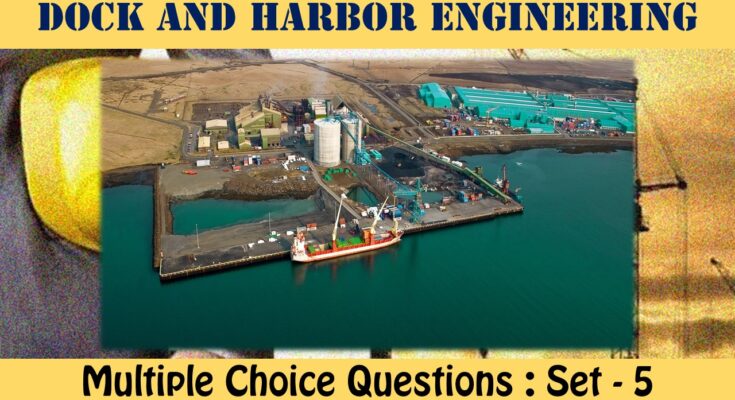MCQ Questions Civil Engineering Design of Masonry Structures
The interviewer is almost as nervous as the candidate in most interviews. You might wonder if you look confident enough, if you will hire the right person, or if you are asking the right engineering interview questions. The last question is arguably the most crucial part to worry about when you’re interviewing candidates. Other topics on Civil Engineering Multiple Choice Questions can be accessed
MCQ Questions Civil Engineering Docks And Harbour Engineering - Set - 5
Question 1:
The significant wave height is defined is the average height of the
(A) One-third highest waves
(B) One-fourth highest waves
(C) One-fifth highest waves
(D) One-tenth highest waves
Correct Answer – (A)
Question 2 :
When a wave strikes a vertical breakwater in deep water, it is reflected back and on meeting another advancing wave of similar amplitude merges and rises vertically in a wall of water. This phenomenon is called
(A) Surf
(B) Clapotis
(C) Fetch
(D) Swell
Correct Answer – (B)
Question 3 :
For designing the dock, the proportion of ship load assumed to be borne by keel blocks is
(A) 5/8
(B) 3/8
(C) 3/16
(D) 5/16
Correct Answer – (A)
Question 4 :
The difference in height between highest high water and lowest low water is called
(A) Mean range
(B) Maximum range
(C) Maximum rise
(D) Mean rise
Correct Answer – (B)
Question 5 :
A ship strikes the berth generally at an angle
(A) 90° with the face of the dock
(B) 45° with the face of the dock
(C) 30° with the face of the dock
(D) 10° with the face of the dock
Correct Answer – (D)
MCQ Questions Civil Engineering Docks And Harbour Engineering
Question 6:
Select the incorrect statement.
(A) The progress of work in low level method of mound construction is very slow
(B) Barge method of mound construction is economical(
C) In low level method of mound construction, the area of working is limited
(D) In staging method of mound construction, the work is not interrupted even during stormy weather
Correct Answer – (B)
Question 7:
As per Berlin’s formula, the length of wave in meters is given by
(Where ’t’ is the period in seconds for two successive waves to pass the same section.)
(A) 1.3412
(B) 1.5612
(C) 1.7412
(D) 1.9412
Correct Answer – (B)
Question 8:
By increasing the rise of lock-gates,
(i) The length of the lock gate will increase
(ii) Transverse stress due to water pressure on the gate will increase
(iii) Compressive force on the gate will increase
Of these statements
(A) (i) and (ii) are correct
(B) (i) and (iii) are correct
(C) Only (ii) is correct
(D) Only (iii) is correct
Correct Answer – (A)
Question 9:
If ‘Hs’ is the significant wave height, then the average wave height and highest wave height respectively are given by
(A) 0.6 Hs and 1.67 Hs
(B) 0.6 Hs and 1.87 Hs
(C) 1.27 Hs and 1.87 Hs
(D) 1.27 Hs and 1.67 Hs
Correct Answer – (B)
Question 10:
In basins subjected to strong winds and tide, the length of the berthing area should not be less than
(A) The length of design vessel
(B) The length of design vessel + 10% clearance between adjacent vessels
(C) The length of design vessel + 20% clearance between adjacent vessels(
D) Twice the length of design vessel
Correct Answer – (C)
- NCERT Solutions Class 12 Mathematics RD Sharma Sets : Exercise 1.1
- NCERT Solutions Class 12 Mathematics RD Sharma Sets : Exercise 1.2
- NCERT Solutions Class 12 Mathematics RD Sharma Sets : Exercise 1.3
- NCERT Solutions Class 12 Mathematics RD Sharma Sets : Exercise 1.4
- NCERT Solutions Class 12 Mathematics RD Sharma Trigonometric Functions : Exercise – 5.1
- NCERT Solutions Class 12 Mathematics RD Sharma Trigonometric Functions : Exercise – 5.2
- NCERT Solutions Class 12 Mathematics RD Sharma Trigonometric Functions : Exercise – 5.3
- NCERT Solutions Class 12 Mathematics RD Sharma Quadratic Equations : Exercise – 14.1
- NCERT Solutions Class 12 Mathematics RD Sharma Quadratic Equations : Exercise – 14.2
- NCERT Solutions Class 12 Mathematics RD Sharma Linear Inequations : Exercise – 15.1
- NCERT Solutions Class 12 Mathematics RD Sharma Linear Inequations : Exercise – 15.2
- NCERT Solutions Class 12 Mathematics RD Sharma Linear Inequations : Exercise – 15.3
- NCERT Solutions Class 12 Mathematics RD Sharma Linear Inequations : Exercise – 15.4
- NCERT Solutions Class 12 Mathematics RD Sharma Linear Inequations : Exercise – 15.5
- NCERT Solutions Class 12 Mathematics RD Sharma Linear Inequations : Exercise – 15.6
Multiple Choice Questions for Competitive Exams
- Multiple Choice Questions Class 12 Chemistry The Solid State
Set -1 Set -2 Set -3 Set -4 Set -5 - MCQ Questions Class 12 Solutions With Answers
Set -1 Set -2 Set -3 Set -4 Set -5 - MCQ Questions Class 12 Electrochemistry With Answers
Set -1 Set -2 Set -3 Set -4 Set -5 - MCQ Questions Class 12 Chemical Kinetics With Answers
Set -1 Set -2 Set -3 Set -4 Set -5 - MCQ Questions Class 12 Surface Chemistry With Answers
Set -1 Set -2 Set -3 Set -4 Set -5 - MCQ Questions Class 12 General Principles and Processes of Isolation of Elements With Answers
Set -1 Set -2 Set -3 Set -4 Set -5




